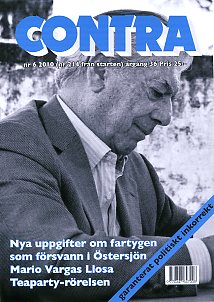
Communists honoured in Stockholm
by C G Holm
In Stockholm there are some less appealing public monuments, monuments of the type that have disappeared in Eastern Europe. There are two monuments commemorating Communist butchers, Mao and Lenin. The Lenin monument specifically honours Lenin’s visit in Stockholm on his way from exile in Zurich to the revolution in Petrograd. In addition there is a monument in memory of Swedish communists fighting in the Spanish civil war.
The ships that disappeared in the Baltic
by C G Holm
During the years after World War II several Swedish ships disappeared in the Southern Baltic. One or two might have sunk due to bad weather, but for several of the ships there are proofs or circumstantial evidence that there were other causes of the disapperance. Read the article here.
New information on disappeared
ships in the Baltic
by Susanne Berger and Kerstin von Seth
During 1948 Swedish defense thought that it was possible that the ships Iwan and Kinnekulle purposely had been captured by the Russians in connection with smuggling operations. Several months before the disappearance of the ships Foreign Secretary Östen Undén met a Swedish captain who hade been questioned by Polish authorities in connection with smuggling operations conducted by Swedish ships. At least once the Swedish Defense staff infiltrated an agent into Poland with the help of a commercial vessel. These questions have been important for Swedish ships that travelled in the dangerous Gdansk-Trelleborg corridor during the Cold War. Read the full text here!
Active communist leaves her past
by Maria Walden
Maria Walden has been active in different Communist movements since age 12. She was ”born a communist” and lived in the Soviet Union for more than ten years. When she moved from the USSR to Sweden in 1990 she immediately joined the stalinist Arbetarpartiet Kommunisterna (APK), now Sveriges Kommunistiska Parti (SKP). She tells that she hardly knew anything about the crimes of communism.
Muhammad’s women
– 13 wives from 9 years old and up
by C G Holm
Muhammad’s relationship to women is only partly dealt with in the Quran. There you mostly get the view of Allah on women in general. But in hadith (recognized narratives on Muhammad not made part of the Quran) there is a lot to find. In the year 595 Muhammad married a distant relative, Khadija, who hade become a widow twice. She was approximately 40 and very wealthy. Muhammed was only 25. They had six children. Khadija died in 619, over 60 years old. During his marriage with Khadija Muhammad had only one wife.
The year after Khadija’s death Muhammad married Sadwa, who hade politically important family connections. Later the same year Muhammad married six year old Aisha. But the marriage was not ”fulfilled” until three years later, Aisha was then nine years old. And then Muhammad continued marrying another ten women. Yes, Allah had said that you should not have more than four wives, but the reason for that was that you could not possibly be just to more than four wives. But it was otherwise for Muhammad, according to a timely revelation he had.
The market friendly voice of Latin America:
Mario Vargas Llosa
by Fredrik Runebert
This year’s Nobel Prize Winner in literature started his career as an author as a Marxist, but today he is one of the most important advocates of the free market economy in Latin America. Mario Vargas Llosa has no prejudices when he looks for the truth. He is one of the few Latin American authors that have been critical to all types of dictatorship.
The Tea Party movement moves on
by Fredrik Runebert
The Tea Party movement dominate the American political scene. Candidates from the Republican establishment have been defeated by candidates from the Tea Party movement. On their agenda you find lower taxes, lower public expenditure, less red tape, opposition to bureaucracy, excessive spending, gallopping budget deficits, stimulus packages, health reform and bail-outs. The movement is divergent and has no defined leader.
The Swedish Financial Supervisory Authority:
Almost unlimited power
without public control
An institution with almost unlimited power on financial markets in Sweden is the Swedish Financial Supervisory Authority. The Authority never needs to fight for their grants, they just write the government to inform them that they increase the charges, as the operations of the authority is fully paid by fees paid by institutions supervised. The authority is very strong as few dare to criticise it in the public domain. Those who are knowledgeable enough on the institution’s operations are working in the financial industry and are dependent on the Authority to keep their salaries.
Two worlds – two ideas:
Russia and China in the Far East
by Frank Gordons
In the Far East, on the shores of the Amur river, two cities ar located opposite each other, the Russian Blagovechchcenska and the Chinese Heihe. More and more of the inhabitants of Blagovechchenska moves across the Amur in order to have a good life on money that they would hardly manage with on the Russian side of the border.

